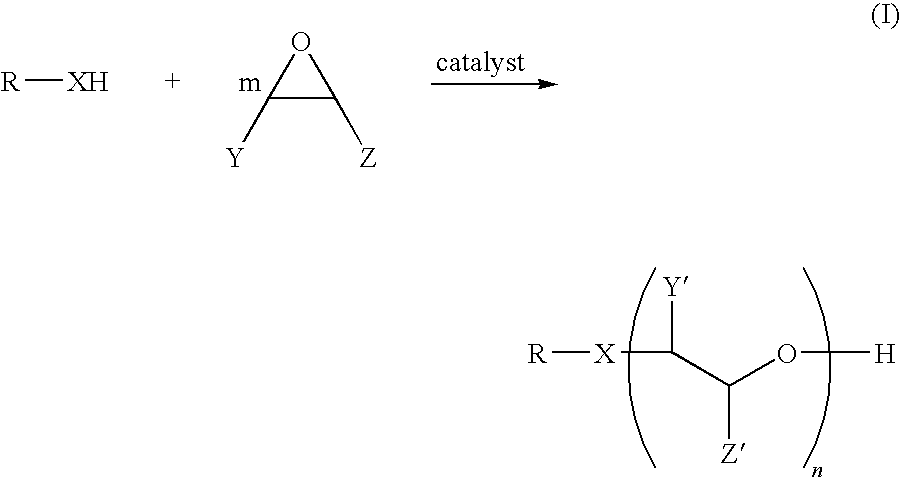Alkoxylate composition and a process for preparing the same
a technology of alkoxylate composition and process, which is applied in the preparation of oxygen-containing compounds, other chemical processes, organic chemistry, etc., can solve the problems of increasing manufacturing costs, reducing the range of alkoxylated products produced by catalysts, and using strongly basic catalysts
- Summary
- Abstract
- Description
- Claims
- Application Information
AI Technical Summary
Benefits of technology
Problems solved by technology
Method used
Image
Examples
example 1
Preparation of a 3% wt DMC Catalyst Slurry in NEODOL 67 Alcohol
[0067]9.00 g of solid DMC catalyst, prepared according to example 2 of EP 1663928, which is herein incorporated by reference in its entirety, is added to a beaker. Subsequently 291.3 g of NEODOL® 67 alcohol is added at room temperature.
[0068]The mixture is stirred for 5 minutes with a high speed high shear stirrer (Ultraturrax) to give a 3% wt DMC catalyst in NEODOL® 67 alcohol slurry.
example 2
Preparation of a Propoxylated-Ethoxylated Branched C16-17 Alcohol Having an Average of 7 Propyleneoxy and 2 Ethyleneoxy Groups Per Molecule
[0069]A 1-litre stirred tank reactor was charged with 273.94 g of NEODOL® 67 alcohol and 0.545 g of the 3% wt the DMC catalyst slurry in NEODOL® 67 alcohol, formed by the process described in Example 1, to attain 20 ppm wt / wt solid DMC catalyst based on end product. Under constant stirring, the reactor tank was flushed three times with nitrogen, by raising the pressure within the reactor tank to 2 bara by addition of nitrogen and subsequently releasing the pressure to atmospheric pressure. The reactor contents were heated, under a nitrogen atmosphere, to a temperature of 130° C. and subsequently stripped by applying a vacuum and a nitrogen purge at a pressure of 100 mbara.
[0070]After 1 hour, the nitrogen purge and vacuum was stopped and 437.4 g of propylene oxide (PO) was added over a period of approximately 2.5 hours. The pressure which was 0.6 ...
example 3
Preparation of a Propoxylated-Ethoxylated (Linear) Cetyl / Stearyl Alcohol Having an Average of 7 Propyleneoxy and 2 Ethyleneoxy Groups Per Molecule
[0073]A 1-litre stirred tank reactor was charged with 278.8 g of cetyl / stearyl alcohol1 preheated to 80° C. and 0.554 g of the 3% wt DMC catalyst slurry in NEODOL® 67 alcohol formed by the process of Example 1, to attain 20 ppm wt / wt solid DMC catalyst based on end product. Under constant stirring, the reactor tank was flushed three times with nitrogen, by raising the pressure within the reactor tank to 2 bara and subsequently releasing the pressure to atmospheric pressure. The reactor contents were heated, under a nitrogen atmosphere, to a temperature of 130° C. and subsequently stripped by applying a vacuum and a nitrogen purge at a pressure of 100 mbara. 1 TA-1618F KU, batch FPG-6231-6102 from The Proctor & Gamble Distributing Company, Cincinnati, Ohio 45241 USA, having the following analysis according to its certificate of analysis: Hy...
PUM
| Property | Measurement | Unit |
|---|---|---|
| temperature | aaaaa | aaaaa |
| temperature | aaaaa | aaaaa |
| temperature | aaaaa | aaaaa |
Abstract
Description
Claims
Application Information
 Login to View More
Login to View More - R&D
- Intellectual Property
- Life Sciences
- Materials
- Tech Scout
- Unparalleled Data Quality
- Higher Quality Content
- 60% Fewer Hallucinations
Browse by: Latest US Patents, China's latest patents, Technical Efficacy Thesaurus, Application Domain, Technology Topic, Popular Technical Reports.
© 2025 PatSnap. All rights reserved.Legal|Privacy policy|Modern Slavery Act Transparency Statement|Sitemap|About US| Contact US: help@patsnap.com



